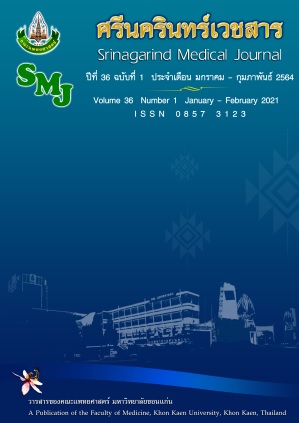Assessment of the Entrance Skin Radiation Dose from the Digital Radiography in Srinagarind Hospital
Abstract
การประเมินปริมาณรังที่ผิวที่ผู้ป่วยได้รับในการถ่ายภาพทางรังสีดิจิทัลในโรงพยาบาลศรีนครินทร์
ต้องจิต มหาจันทวงศ์1, ธวัชชัย ปราบศัตรู1,2,*, วรนันท์ คีรีสัตยกุล1,2, สมศักดิ์ วงษาศานนท์1 วราภรณ์ สุดใจ3
1ภาควิชารังสีวิทยา คณะแพทยศาสตร์ มหาวิทยาลัยขอนแก่น
2กลุ่มวิจัยรังสีวิทยาหลอดเลือดและรังสีร่วมรักษาระบบประสาท คณะแพทยศาสตร์ มหาวิทยาลัยขอนแก่น
3สถาบันเทคโนโลยีนิวเคลียร์แห่งชาติ
บทคัดย่อ
หลักการและวัตถุประสงค์: การถ่ายรังสีดิจิทัลถือเป็นการวินิจฉัยโรคโดยทั่วไป ที่เพิ่มจำนวนมากขึ้นอย่างมีนัยสำคัญในการตรวจด้วยรังสีเอกซ์ ทำให้ผู้ป่วยที่เข้ารับการตรวจทางรังสีมีความเสี่ยงจากการได้รับรังสีเพิ่มมากขึ้น การศึกษานี้มีวัตถุประสงค์เพื่อประเมินปริมาณรังสีที่ผิวผู้ป่วยได้รับ (entrance skin dose,ESD) ในการถ่ายภาพรังสีดิจิทัลในท่าทั่วไป ของโรงพยาบาลศรีนครินทร์ คณะแพทยศาสตร์ มหาวิทยาลัยขอนแก่น และเปรียบเทียบค่าปริมาณรังสีที่ผิวได้รับกับค่าระดับปริมาณรังสีอ้างอิง (diagnostic reference level,DRL) ของหน่วยงานระดับและระดับนานาชาติ รวมทั้งมีการศึกษาถึงปัจจัยที่มีผลต่อปริมาณรังสีที่ผิวผู้ป่วย
วิธีการศึกษา: เป็นการศึกษาย้อนหลัง ตั้งแต่เดือนมกราคม ถึง พฤษภาคม พ.ศ. 2562 จากระบบการจัดเก็บรูปภาพทางการแพทย์ โดยเก็บข้อมูลพารามิเตอร์สำหรับการถ่ายภาพรังสีดิจิทัลจากผู้ป่วยจำนวน 1,010 ราย ที่หน่วยรังสีวินิจฉัย ภาควิชารังสีวิทยา คณะแพทยศาสตร์ มหาวิทยาลัยขอนแก่น จากการถ่ายภาพรังสีทรวงอก กระดูกสันหลังส่วนคอ ส่วนอกและส่วนเอว กะโหลกศีรษะ ในด้านตรง (anteroposterior; AP) และด้านข้าง (Lateral view; LAT) การถ่ายภาพรังสีช่องท้องและกระดูกเชิงกรานด้าน AP คำนวณหาปริมาณรังสี ESD โดยใช้สูตรคำนวณเฉพาะ วิเคราะห์ข้อมูลโดยใช้สถิติพรรณนา และหาความสัมพันธ์ระหว่างปริมาณรังสี ESD และค่าพารามิเตอร์สำหรับการถ่ายภาพรังสีดิจิทัล
ผลการศึกษา: ผลการศึกษาพบว่า Chest LAT ใช้ค่าความต่างศักย์ไฟ้ฟ้า (kVp) สำหรับการถ่ายภาพสูงที่สุด ส่วน Lumbar spine LAT ใช้ค่ากระแสหลอดคูณกับเวลา (mAs) สูงที่สุด ค่ามัธยฐานปริมาณรังสี ESD ของการถ่ายภาพรังสีดิจิทัลทุกส่วนมีค่าต่ำกว่าค่าระดับปริมาณรังสีอ้างอิงมาตรฐานนานาชาติ (IAEA) ในขณะที่ ESD ของการถ่าย chest PA, abdomen AP, pelvis AP, lumbar spine LAT และ skull AP/PA มีค่าต่ำกว่า DRL ในระดับชาติ ยกเว้น Lumbar spine AP และ skull LAT ที่มีค่า ESD สูงกว่า มากไปกว่านั้นยังมีการเปรียบเทียบ ESD ของการศึกษานี้กับค่า DRL ประเทศญี่ปุ่นและสหราชอาณาจักร โดยการเปรียบเทียบค่า ESD กับ DRL ของประเทศญี่ปุ่นได้ผลการเปรียบเทียบเหมือนกับค่า DRLในระดับชาติ ในขณะที่เปรียบเทียบกับค่า DRL ของสหราชอาณาจักรพบว่าค่า ESD ของการถ่ายภาพรังสีส่วน abdomen AP, pelvis AP and lumbar spine LAT น้อยกว่าค่า DRL ของสหราชอาณาจักร ส่วนการถ่ายภาพรังสีส่วน chest PA, lumbar spine AP, skull AP/PA และ skull LAT มีค่า ESD มากกว่า นอกจากนี้พบว่าค่า mAs มีความสัมพันธ์ในระดับสูงในทิศทางเดียวกันกับค่า ESD ในขณะที่น้ำหนัก อายุและ kVp มีความสัมพันธ์ในระดับต่ำกับค่า ESD
สรุป: การศึกษาครั้งนี้ทำให้หน่วยงานได้ทราบค่า ESD อ้างอิงในผู้ป่วยที่รับการถ่ายภาพรังสีดิจิทัลและได้เปรียบเทียบค่า ESD กับค่า DRL ของหน่วยงานระดับชาติ นานาชาติ ประเทศญี่ปุ่น และสหราชอาณาจักร โดยเมื่อค่า ESD สูงกว่าค่า DRL ของหน่วยงานระดับชาติและนานาชาติ นักรังสีการแพทย์และทีมงานควรสืบค้นและหาสาเหตุของปัญหาว่าเกิดจากอะไร ควรตรวจสอบโปรแกรมการประกันคุณภาพและประสิทธิภาพของเครื่องเพื่อให้แน่ใจถึงประสิทธิภาพของเครื่องเอกซเรย์และปริมาณรังสีที่ออกมา หลังจากนั้นควรมีการทบทวนโปรโตคอลและเทคนิคการให้ปริมาณรังสีแก่ผู้ป่วย ในขั้นตอนต่อไปคือการ optimization เพื่อปรับลดปริมาณรังสีในผู้ป่วยลงและจำกัดความเสี่ยงที่จะเกิดขึ้นกับผู้ป่วย
คำสำคัญ: การถ่ายภาพรังสีดิจิทัล; ปริมาณรังสีที่ผิวที่ผู้ป่วยได้รับ; ปริมาณรังสีอ้างอิง
AbstractBackground and objectives: Digital radiography is a common diagnostic practice and it has been a significant increase in the number of x-ray examinations. Patients were frequently exposed to radiation may consider increasing the risk of exposure to radiation. The purpose of this study was set up to evaluate the entrance skin dose (ESD) in common digital radiography in Srinagarind hospital, faculty of medicine, Khon Kaen university and compared to ESD with national and international diagnostic reference level (DRL) including study of parameters which effect the ESD.
Material and method: The retrospective study was conducted from January to May 2019 by using picture achieving communication systems (PACS). The digital radiographic parameters from total 1,010 patients from 12 examinations including chest, cervical spine, thoracic spine and lumbar spine, skull in anteroposterior/posteroanterior (AP/PA) view and lateral view, abdomen and pelvis in AP view were recorded. The ESD was calculated using the specific formula. All data were analyzed using descriptive analysis and the correlation of digital radiographic parameters and ESD was also analyzed.
Result: The result showed that the highest kVp for DR was observed in chest LAT while the highest mAs was observed in lumbar spine LAT. The median ESD of all digital radiography examination was lower than the international IAEA DRL value while the median of ESD of chest PA, abdomen AP, pelvis AP, lumbar spine LAT and skull AP/PA was lower than Thai national DRL except for the median ESD of lumbar spine AP and skull LAT were higher than national DRL. Moreover, the median ESD was compared with the Japanese and United Kingdom (UK) DRL. The comparison between ESD and Japanese DRL was showed the result like the Thai national DRL. While the comparison between ESD and UK DRL, the median ESD of abdomen AP, pelvis AP and lumbar spine LAT were lower than UK DRL except for the median ESD of chest PA, lumbar spine AP, skull AP/PA and skull LAT were higher than UK DRL. In addition, mAs showed a high positive correlation with ESD while weight, age and kVp were showed a low correlation with ESD.
Conclusion: This study provided the median ESD in Srinagarind hospital and already compared with national DRL, international IAEA DRL, Japanese DRL and UK DRL. When the median ESD was higher than national and international DRL, technologist and team member could investigate and determine the cause of problem. The quality assurance program and efficiency of X-ray machine firstly check to ensure the good performance of the machine and radiation output and then the protocol and exposure technique were also revised. Further step, dose optimization is required to reduce the patient dose and limit the stochastic effect risk.
Keyword : Digital Radiography; Entrance Skin Dose; Diagnostic reference level


